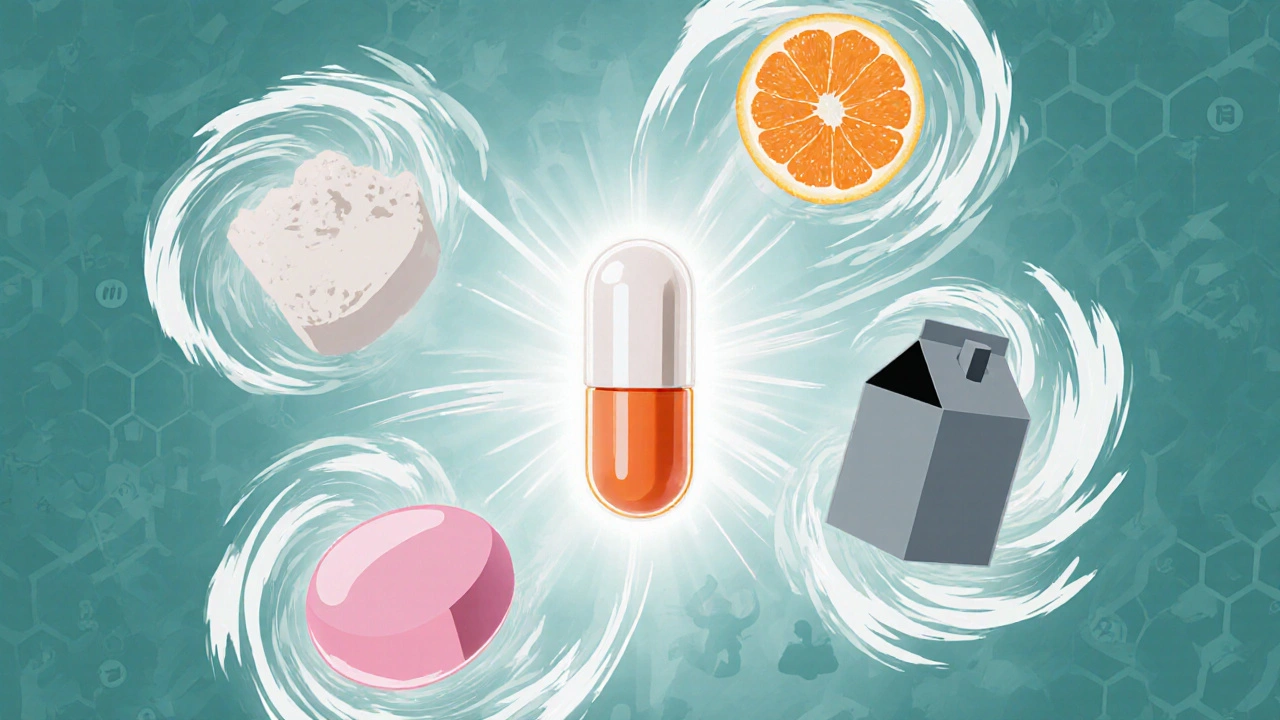Minocycline Interaction Checker
Check Your Interaction Risk
Select any medications or supplements you're taking with minocycline to get personalized timing advice.
Interaction Results
When you take Minocycline is a broad‑spectrum tetracycline antibiotic used for acne, respiratory infections, and certain tick‑borne diseases, you probably focus on the infection it clears. But the real challenge shows up when minocycline drug interactions sneak into the picture, turning a simple regimen into a safety puzzle. Below you’ll find everything you need to spot, avoid, and manage those interactions - from prescription pills to everyday foods.
What Is Minocycline and How Does It Work?
Minocycline belongs to the tetracycline family, a class of antibiotics that block bacterial protein synthesis by binding to the 30S ribosomal subunit. This stops microbes from growing, giving your immune system a chance to clear the infection. Typical doses range from 50 mg to 100 mg twice daily, and treatment lengths vary from a few days (for respiratory infections) to several months (for acne).
Because it’s lipophilic, minocycline penetrates skin, bone, and even the central nervous system better than older tetracyclines. That broad reach is a double‑edged sword: it also means the drug can mingle with many other substances, changing how they act or how the body processes them.
Why Do Drug Interactions Happen?
Interactions arise when two compounds influence each other’s absorption, metabolism, or elimination. With minocycline, the most common mechanisms are:
- Chelation: Minerals like calcium, magnesium, iron, and zinc bind to the antibiotic, forming complexes that the gut can’t absorb.
- Enzyme inhibition or induction: Some drugs affect liver enzymes (especially CYP3A4) that also handle minocycline, leading to higher or lower blood levels.
- Altered protein binding: Minocycline is ~70% protein‑bound; other highly bound drugs can displace it, raising free‑drug concentrations.
Understanding these pathways helps you anticipate which medicines, supplements, or foods could tip the balance.
Prescription Medications That Interact with Minocycline
The table below lists the most clinically relevant prescription drugs, the type of interaction, and the recommended action.
| Drug | Interaction Type | Clinical Effect | Management |
|---|---|---|---|
| Warfarin | Pharmacodynamic | Increased anticoagulant effect → higher bleeding risk | Monitor INR closely; consider dose adjustment of warfarin |
| Oral contraceptives | Enzyme induction (CYP3A4) | Reduced efficacy → risk of unintended pregnancy | Use backup contraception; discuss alternative antibiotics |
| Methotrexate | Additive toxicity | Increased risk of hepatotoxicity and bone‑marrow suppression | Avoid concurrent use if possible; if needed, monitor liver enzymes and blood counts |
| Antacids containing aluminium or magnesium | Chelation | Reduced minocycline absorption → therapeutic failure | Separate dosing by at least 2‑3 hours |
| Isotretinoin | Pharmacodynamic | Higher risk of intracranial hypertension | Use under specialist supervision; monitor for headaches or visual changes |
Supplements, Vitamins & Foods That Can Affect Minocycline
Even items that seem harmless can interfere.
- Calcium‑rich foods or supplements - dairy, fortified orange juice, calcium tablets. Chelation drops absorption.
- Iron or zinc supplements - common in multi‑vitamins; same chelation problem.
- Vitamin D - high‑dose regimens may compete for the same binding sites, potentially altering free drug levels.
- Alcohol - can increase the risk of vestibular side effects (dizziness, vertigo) and liver strain.
- Grapefruit juice - a CYP3A4 inhibitor; may raise minocycline plasma concentrations, modestly raising toxicity risk.
Practical tip: take minocycline with a full glass of water on an empty stomach, and wait at least two hours before consuming any of the items above.
Lifestyle Factors and Over‑the‑Counter (OTC) Products
OTC drugs are easy to overlook, yet some are notorious interaction culprits.
- NSAIDs (ibuprofen, naproxen) - can add to the risk of gastrointestinal irritation, especially if you already have a sore throat from the infection.
- Antihistamines - may amplify dizziness or light‑headedness caused by minocycline.
- Smoking - induces liver enzymes, potentially lowering minocycline levels.
Keeping a short medication diary (prescription, OTC, supplements) lets you and your pharmacist spot red flags before they become problems.

Special Populations: Pregnancy, Seniors, and Renal Impairment
Pregnancy: Minocycline is classified as Pregnancy Category D in many regions because it can cross the placenta and affect fetal bone growth. Women who are pregnant or planning pregnancy should discuss alternative antibiotics with their provider.
Elderly patients: Age‑related reductions in kidney function can slow minocycline clearance, increasing the chance of dizziness, confusion, or rare intracranial hypertension. Dose adjustments and close monitoring are advised.
Renal or hepatic impairment: Since the drug is eliminated both renally and hepatically, severe dysfunction may require dose reduction. Check serum creatinine and liver enzymes periodically.
How to Manage and Prevent Interactions
- Full medication review - before starting minocycline, list every prescription, OTC, supplement, and herb.
- Timing is key - separate minocycline from calcium, iron, magnesium, and antacid products by at least 2‑3 hours.
- Watch lab values - for patients on warfarin, methotrexate, or liver‑impacting drugs, schedule INR, liver‑function, and blood‑count checks.
- Stay alert to symptoms - sudden headaches, vision changes, yellowing skin, severe dizziness, or unexplained bruising warrant immediate medical attention.
- Communicate - inform your pharmacist and all your healthcare providers that you’re on minocycline; they can flag interactions before new meds are added.
Following these steps reduces the odds of a nasty surprise and keeps the treatment effective.
When to Seek Immediate Medical Help
Even with careful planning, rare but serious reactions can occur. Call emergency services or go to the nearest emergency department if you experience:
- Severe skin rash or blistering (possible Stevens‑Johnson syndrome)
- Sudden, severe headache or visual disturbances (signs of intracranial hypertension)
- Unexplained bleeding or bruising (especially on warfarin)
- Yellowing of the eyes or skin (liver injury)
- Swelling of the face, lips, tongue, or throat (allergic reaction)
Quick Recap
- Minocycline is a potent tetracycline antibiotic; its lipophilicity gives it broad reach but also many interaction pathways.
- Key prescription culprits: warfarin, oral contraceptives, methotrexate, antacids, isotretinoin.
- Supplements/foods to watch: calcium, iron, zinc, vitamin D, alcohol, grapefruit juice.
- Separate dosing by 2‑3 hours, keep a medication diary, and monitor labs when needed.
- Pregnant women, seniors, and patients with kidney or liver issues need dose tweaks and close follow‑up.

Can I take calcium supplements while on minocycline?
Calcium binds to minocycline and cuts its absorption by up to 50%. If you need calcium, take it at least 2‑3 hours before or after the antibiotic. Better yet, discuss timing with your pharmacist.
Does minocycline affect birth control pills?
Yes. Minocycline can induce liver enzymes that lower hormone levels, making oral contraceptives less reliable. Use a backup method (condoms or a copper IUD) while you’re on the antibiotic.
What should I do if I miss a dose?
Take the missed tablet as soon as you remember, unless it’s almost time for the next dose. In that case, skip the missed one - don’t double‑dose. Consistency helps keep blood levels steady and reduces interaction risk.
Is it safe to drink alcohol while on minocycline?
Alcohol itself doesn’t change minocycline levels, but it can worsen dizziness and increase liver strain. If you already have liver issues or take other hepatotoxic drugs, limit or avoid alcohol.
How long does it take for an interaction to show up?
Some interactions, like chelation with calcium, affect absorption immediately. Others, like warfarin potentiation, may take a few days as blood‑clotting factors change. Monitoring labs at 3‑5 days after starting minocycline is a safe rule of thumb.


Hi, I'm Caden Lockhart, a pharmaceutical expert with years of experience in the industry. My passion lies in researching and developing new medications, as well as educating others about their proper use and potential side effects. I enjoy writing articles on various diseases, health supplements, and the latest treatment options available. In my free time, I love going on hikes, perusing scientific journals, and capturing the world through my lens. Through my work, I strive to make a positive impact on patients' lives and contribute to the advancement of medical science.